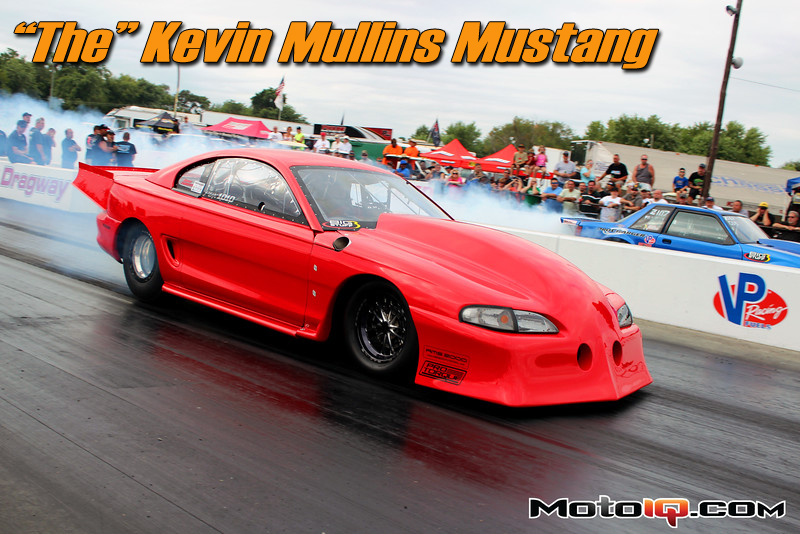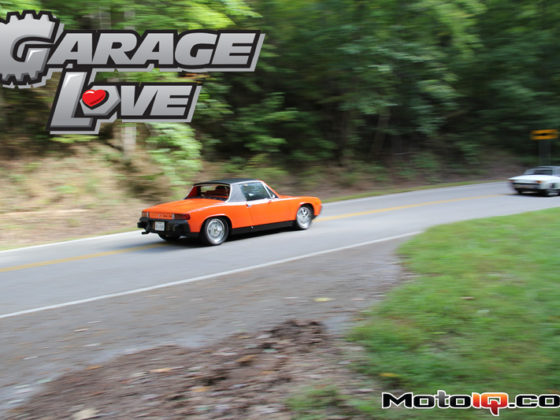,
 Twin Moran Motorsports 500 LB/HR injectors are used on each cylinder. Approximately 3-4 gallons of alcohol are consumed during each low-4 second pass down the 1/8 mile, pushed through the injectors by a mechanical cam-driven fuel pump. It takes a lot of go-juice to reach almost 200MPH in only 660 feet!
Twin Moran Motorsports 500 LB/HR injectors are used on each cylinder. Approximately 3-4 gallons of alcohol are consumed during each low-4 second pass down the 1/8 mile, pushed through the injectors by a mechanical cam-driven fuel pump. It takes a lot of go-juice to reach almost 200MPH in only 660 feet! The heart of “The” Kevin Mullins' ride is controlled by a Big Stuff 3 powertrain management system. An NLR Control Products AMS-2000 Boost Controller is employed to manage the insane boost levels with extreme precision. The tanks you see here are not nitrous, but rather carbon dioxide and fire extinguishers. CO2 is used for many things on a high-performance drag car these days.
The heart of “The” Kevin Mullins' ride is controlled by a Big Stuff 3 powertrain management system. An NLR Control Products AMS-2000 Boost Controller is employed to manage the insane boost levels with extreme precision. The tanks you see here are not nitrous, but rather carbon dioxide and fire extinguishers. CO2 is used for many things on a high-performance drag car these days.For example, the AMS-2000 manages CO2 pressure at the wastegate to control boost, and does so based on elapsed time (and other parameters) after the launch. Boost is carefully manipulated throughout the entirety of the run in an attempt to put down the maximum amount of power without slipping the tire.
 The parachutes' deployment is additionally assisted by CO2. When you're trying to haul 3200lbs of car down from 190MPH+ speeds, you want all the help you can get. With all the mention of wheelies, you'll notice one thing is curiously absent: wheelie bars. Class rules prohibit their use, which means launch tuning is all the more important. The bar sticking out of the back? It's so they can push the car in the staging lanes with a golf cart, quad or other vehicle. Running a competitive drag team at this level involves several vehicles – a truck, trailer, race car, push vehicle, and possibly a street car all have to get transported to and from the track.
The parachutes' deployment is additionally assisted by CO2. When you're trying to haul 3200lbs of car down from 190MPH+ speeds, you want all the help you can get. With all the mention of wheelies, you'll notice one thing is curiously absent: wheelie bars. Class rules prohibit their use, which means launch tuning is all the more important. The bar sticking out of the back? It's so they can push the car in the staging lanes with a golf cart, quad or other vehicle. Running a competitive drag team at this level involves several vehicles – a truck, trailer, race car, push vehicle, and possibly a street car all have to get transported to and from the track. When you're focused exclusively on getting to the 1/8 mile mark as fast as possible, you can get away with only two speeds. The Mustang employs a Proformance Racing Transmissions Turbo 400 automatic mated to a ProTorque High Performance Drag Racing Torque Converter. CO2 here, again, plays a role in assisting with shifting the transmission. Additionally, CO2 is used to manipulate solenoid pressure on the torque converter to control lock-up, slip and other parameters throughout the run. An MSD “2-step” launch controller is employed.
When you're focused exclusively on getting to the 1/8 mile mark as fast as possible, you can get away with only two speeds. The Mustang employs a Proformance Racing Transmissions Turbo 400 automatic mated to a ProTorque High Performance Drag Racing Torque Converter. CO2 here, again, plays a role in assisting with shifting the transmission. Additionally, CO2 is used to manipulate solenoid pressure on the torque converter to control lock-up, slip and other parameters throughout the run. An MSD “2-step” launch controller is employed. Santhuff double-adjustable shocks are used up front. To the left, a Racecraft travel limiter helps keep the wheels in check when the front end comes up off the ground. To the right, a travel sensor keeps tabs on the position of the front wheels throughout the run. In the background, Racepak V-Net – more on that in a moment. You can see that the exhaust (top of frame) has been clearanced to keep the tire from hitting it too much during bigger-wheelie launches. While big wheelies are easy for Mullins and all of the Mustang's power, they are not the goal.
Santhuff double-adjustable shocks are used up front. To the left, a Racecraft travel limiter helps keep the wheels in check when the front end comes up off the ground. To the right, a travel sensor keeps tabs on the position of the front wheels throughout the run. In the background, Racepak V-Net – more on that in a moment. You can see that the exhaust (top of frame) has been clearanced to keep the tire from hitting it too much during bigger-wheelie launches. While big wheelies are easy for Mullins and all of the Mustang's power, they are not the goal.


